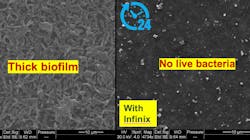Improving composite restoration longevity with anticaries technology
What do you believe is a reasonable expectation for composite restoration longevity? You can be sure that patients think their shiny new tooth will last a lifetime. Premature restorative failure is frustrating for patients and dentists alike, with secondary caries being a leading cause and elusive nemesis.
To a point, meticulous clinical technique can reduce the risk of recurrent decay and restorative failure. However, with so many risk factors out of the dentist’s control, improved longevity depends on a breakthrough in composite formulations themselves.
The longevity trade-off
There’s no question that resin composites are an important part of the modern restorative armamentarium. Obvious benefits include superior aesthetics, fast bonding, and greater preservation of healthy tooth structure. “Composites have seen incredible advances in the last 20 years. They’ve come a long, long way,” said Dr. John Flucke, practice owner, technology evangelist, and self-confessed materials geek. “But when it comes to composites, the profession continues to battle with an increased rate of recurrent decay.”
A range of studies show that traditional composites last between two and five years, versus amalgam, which typically lasts a decade or more. “Amalgam isn't pretty. It corrodes,” Flucke says. “Some folks have allergies. But say what you will about it, we didn’t see the frequency of recurrent caries that we do with composites. In the good old days when we were doing primarily amalgams, no one thought about replacing restorations every two to five years.”
Addressing longevity with next generation materials
Nobio, a material sciences company that specializes in nano particle technology, has taken a unique approach to creating long-lasting composites. The company will launch its Infinix family of advanced dental restoratives and bonding agents in early 2022.
“Infinix is the first FDA-cleared composite shown to reduce the risk of demineralization and secondary caries,” said John Scott, Nobio chief commercial officer. The composites and bonding agent are formulated with Nobio’s patented nonsoluble quaternary-ammonia silica (QASi) antimicrobial nanoparticles.
“Our technology is fundamentally different than fluoride-emitting glass ionomers, which are rapidly depleted, or antimicrobial rinsing agents, which have a short duration effectivity. The electronically charged QASi particles become part of the polymerized composite and provide long-lasting kill of cariogenic bacteria when they contact the restorative surface,” Scott said.
Clinical experience and practice potential
Dr. Flucke has been among the first dentists to use Infinix on his cases. “Imagine a composite that fights decay for you. And by the way, it’s an incredible restorative material. It looks beautiful. It handles as well as any of the restoratives in my practice,” he said. “I think this technology has a real chance at becoming a big gamechanger in dentistry. Dentists owe it to their patients to take a good look when Infinix becomes available.”
Scott, a 15-year dental industry veteran, has a vision for Infinix that goes beyond the clinical. He views premature restoration failures caused by secondary caries—which are commonly acknowledged in both the scientific literature and by practicing professionals—as a business problem that deserves a solution. “Realistic or not, patients have an expectation that a restoration will last much longer than two years. And regardless of the reason for the failure, it reflects on the dentist and the practice. It’s an issue of both patient satisfaction and practice efficiency,” he said.
Beyond composites
The product line will launch in February 2022 and will include universal and flowable composites, as well as a universal light-cured bonding system, all incorporating Nobio’s QASi particles. A bulk-fill flowable composite will be launched later in 2022. Restoratives are the first dental use case of the fundamental technology platform that will ultimately be applied to a wide range of dental products, covering clinical applications that can benefit from long-lasting antimicrobial activity.
Visit Nobio.com and Infinix.com to learn more.
About the Author
John Kringel
John Kringel is Chief Operating Officer of Cellerant Consulting Group, dentistry’s leading corporate incubator and accelerator. Prior to joining Cellerant, Kringel served in various executive roles with leading medical device and dental industry manufacturers.
